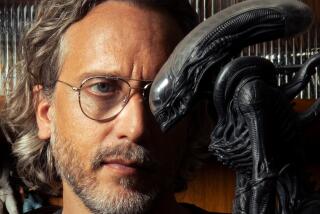Newsletter: Classic Hollywood: ‘Suspicion’ on Blu-ray and Cinema Treasures
- Share via
This is Kevin Crust, and I am your new tour guide as we continue to write about notable birthdays and deaths, movie and TV milestones, fun events around town and the latest in DVDs, soundtracks and books every Friday in our Classic Hollywood newsletter. You can also follow us on the Classic Hollywood Los Angeles Times Facebook page, and our film staff will continue to write about historic Tinseltown.
Suspicious minds
“Suspicion,” directed by Alfred Hitchcock and starring Joan Fontaine and Cary Grant, opened in November 1941. The film was nominated for three Academy Awards, including best picture and best score, and Fontaine won for best actress. On Tuesday, April 12, Warner Archive is releasing a Blu-ray edition of the film to commemorate its 75th anniversary.
When the film opened, Hitchcock was already a big-deal director. He had a stellar career in Britain before David O. Selznick brought him to Hollywood in 1939, and he directed 1940’s Oscar winner for best picture, “Rebecca.” All of that set a high bar.
Many critics pegged “Suspicion” as a middling effort for the burgeoning auteur. Even today, most aficionados place the film well into the teens when ranking Hitchcock’s 50-plus films. Reviewers were particularly torn over the film’s ending, which differed from that of the Francis Isles novel “Before the Fact,” on which the movie was based.
Times critic Philip K. Scheuer found favor in that same ending in an Oct. 12, 1941, piece he’d written on upcoming films:
“‘Suspicion,’ Mr. Hitchcock’s latest, is a more honest, less pretentious ‘Rebecca.’ And it goes further — actually tops it. Still master of the casual, ‘Hitch’ epitomizes his title in a spine-tingler — literally! — about a wife (Joan Fontaine) who suspects her husband, Cary Grant, of having murderous designs on her. The ending, one of many shot, has been criticized as abrupt. That, I think, is what makes it effective.”
However, when another Times critic, Edwin Schallert, reviewed “Suspicion” upon its release, he delivered a more mixed verdict. “Yes, indeed, the web is tightly spun, so that at times even the audience believes as the woman does,” writes Schallert. “At other times doubt intrudes. This is where ‘Suspicion’ shines as especially deft and adroit, and loyal also to Hitchcock precedent for keeping both characters and spectators guessing in different ways.” But when it came to the film’s climax, Schaller found the ending “possibly somewhat abrupt.”
—
Hitchcock himself claimed to be displeased with the ending in his famous interview with Francois Truffaut, describing a scene that was never shot. According to Hitchcock, RKO did not want to portray Grant as a killer, and at one point the studio cut out everything that made the actor appear sinister, leaving a 55-minute film. Fortunately, the director was allowed to restore the footage, if not the ending he wanted.
Said Hitchcock: “Well, I’m not too pleased with the way ‘Suspicion’ ends. I had something else in mind. The scene I wanted, but it was never shot, was for Cary Grant to bring her a glass of milk that’s been poisoned and Joan Fontaine has just finished a letter to her mother: ‘Dear mother, I’m desperately in love with him, but I don’t want to live because he’s a killer. Though I’d rather die, I think Society should be protected from him.’ Then, Cary Grant comes in with the fatal glass and she says, ‘Will you mail this letter to mother for me, dear?’ She drinks the milk and dies. Fade out and fade in on one short shot: Cary Grant, whistling cheerfully, walks over to the mailbox and pops the letter in.”
—
Fontaine won the Academy Award for her performance, but she almost didn’t qualify. Although the film opened in New York in November 1941, it did not play in Los Angeles until January 1942. After Fontaine won the New York Critics Circle Award for best actress, RKO scheduled a special screening at the Pantages on Jan. 12, the final day of eligibility under academy rules at that time.
Cinema Treasures
“Suspicion” opened in Los Angeles at the RKO Hillstreet and the Pantages Hollywood. The Pantages is still going strong as a concert venue and the host to touring Broadway productions after several major renovations over the years. But whatever happened to the Hillstreet?
According to Cinema Treasures, the RKO Hillstreet, downtown at Hill and 8th streets, opened in 1922 and closed in 1963. The building was torn down in 1965 and replaced by a bank. It most recently was a nightclub called the Vault. However, its sister theater in San Francisco, the Golden Gate, is still standing and serves as a performing arts center. The stage play “An Act of God” with Sean Hayes, which had a recent run at the Ahmanson, is playing there.
If you’re not familiar with Cinema Treasures, you should be. It’s a terrific resource for movie buffs and researchers alike, with valuable information about movie theaters of all shapes and sizes from movie palaces to multiplexes. There are histories, photographs, maps and, perhaps best of all, comment sections where registered users share all manner of data relating to their passion for these venues.
Stumble across a reference to a theater you’ve never heard of? Discover if it’s still standing or what became of it. See a building that was clearly once a place for movies? This is the place to get the back story. One of my favorite restaurants, Mohawk Bend in Echo Park, began as a movie theater in 1914. I like to sit in the back where the screen once was and imagine all the old films that screened in that room.
In 2011, the New York Times did a nice piece on the founders, Ross Melnick and Patrick Crowley.
‘The greatest high adventure ever filmed!’*
The American Cinematheque continues its series “Standing Tall: A Century of Gregory Peck” on Sunday with “The Guns of Navarone” (1961).
In his June 30, 1961, review, The Times’ John L. Scott wrote:
“Big, suspenseful, full of muscles — that’s ‘Guns of Navarone,’ the best adventure movie to hit the screen this year [1961]. Carl Foreman’s production, which was filmed on the island of Rhodes in the Aegean Sea and in Great Britain, provides 155 minutes of exciting entertainment.
“This is the story of a military mission filled with action and intense, outstanding portrayals by Gregory Peck, David Niven, Anthony Quinn, Stanley Baker, James Darren and others in its international cast. It relates a straightforward tale of a rough, tough team of Allied saboteurs of World War II whose seemingly impossible job it is to blow up two huge German cannons which have been shelling British warships.”
“Guns of Navarone,” American Cinematheque, Egyptian Theatre, 7612 Hollywood Blvd., Hollywood, (323) 466-3456. 7:30 p.m. Sunday.
*Or so claimed the film’s poster.
Restored version of ‘When You’re in Love’ airs
Attention, Cary Grant fans: A newly restored version of the seldom-seen 1937 musical comedy “When You’re in Love,” starring Grant and opera singer Grace Moore, debuts on GetTV on May 6 at 5 p.m. PDT.
Grant plays an American artist marooned in Mexico because he can’t pay his hotel bill, while Moore is an Australian who needs a marriage of convenience to solve her citizenship troubles.
When it opened, Los Angeles Times critic Edwin Schallert called the film “very clever,” citing Grant’s light comedic performance as his best up to that time. Moore’s rendition of Cab Calloway’s “Minnie the Moocher” was also touted by reviewers as a highlight.
Originally released by Columbia, the film marked the lone feature directing credit of screenwriter Robert Riskin, who received an uncredited assist from Harry Lachman. Other songs are by composer Jerome Kern and lyricist Dorothy Fields. As part of an attempted comeback, silent film star Louise Brooks appears uncredited in the chorus.
‘Not to be Missed’
The Times’ film critic Kenneth Turan introduces the Preston Sturges classic, “The Lady Eve” (1941), Sunday at the Aero in Santa Monica. “All of Sturges’ films are notable for the strong and savvy roles they offered to actresses,” wrote Turan in 1998, “but Barbara Stanwyck made the most of her opportunities. In ‘The Lady Eve,’ perhaps the most brilliant of Sturges’ films, she starts out as a coldblooded con woman looking to fleece Henry Fonda’s awkward snake fancier and brewery heir and ends up taking advantage of a plot twist too audacious for words. Before the screening, at 6:30 p.m., Turan signs his book, “Not to Be Missed: Fifty-Four Favorites From a Lifetime of Film” in the lobby of the theater.
American Cinematheque, Aero Theatre, 1328 Montana Ave., Santa Monica. (310) 260-1528. “The Lady Eve” (1941). 7:30 p.m. Sunday.
From the Hollywood Star Walk
Notable births this week include Sonja Henie (April 8); Mary Pickford (April 8); Dennis Quaid (April 9); Paul Robeson (April 9); Chuck Connors (April 10); Joel Grey (April 11); Claire Danes (April 12); Andy Garcia (April 12); Ann Miller (April 12); Ed O’Neill (April 12); Howard Keel (April 13); and Gene Raymond (April 13).
La Reina
A native of Durango, Mexico, Dolores Del Rio was educated in a convent, then studied in Madrid and Paris before becoming a society matron. However, after being “discovered,” she transformed into a Hollywood movie star of the late silent/early talkie era of the 1920s and ‘30s.
Del Rio was typecast, first as a female “Latin lover,” and then as a series of “exotics.” She returned to Mexico, where she was an award-winning star in the Golden Age of Mexican cinema in the 1940s and ‘50s, as well as working with Orson Welles — following an affair — in “Journey Into Fear” (1942) and John Ford in “The Fugitive” (1947) and “Cheyenne Autumn” (1964).
Read the Los Angeles Times obituary from April 13, 1983.
-------------
More to Read
Only good movies
Get the Indie Focus newsletter, Mark Olsen's weekly guide to the world of cinema.
You may occasionally receive promotional content from the Los Angeles Times.










